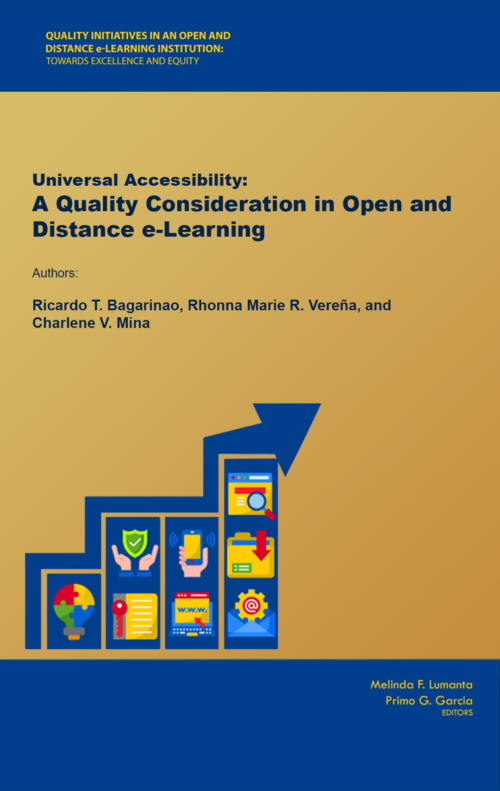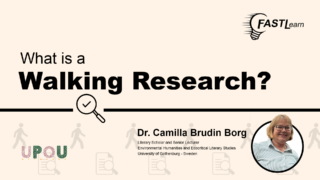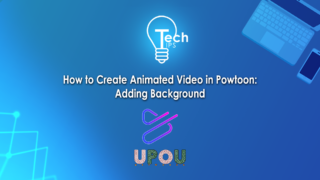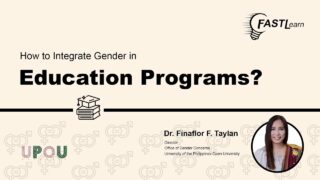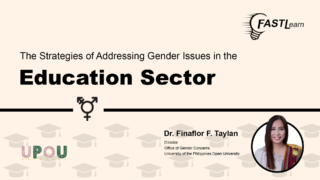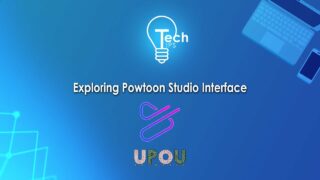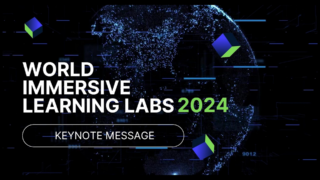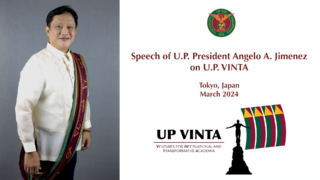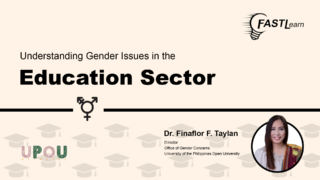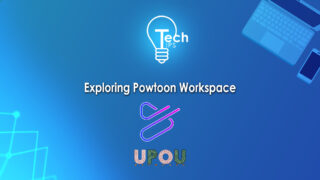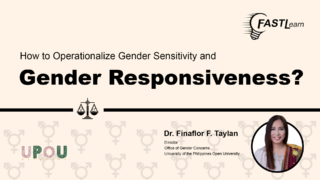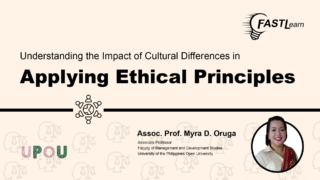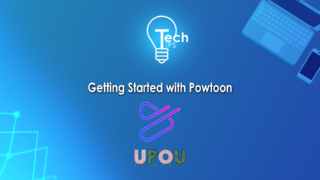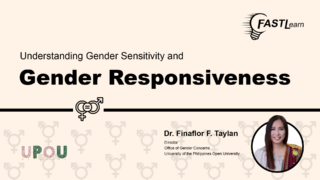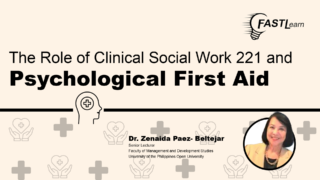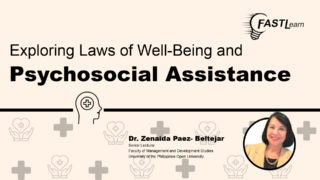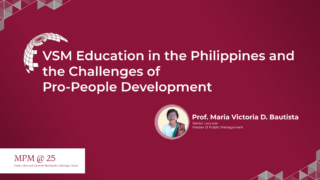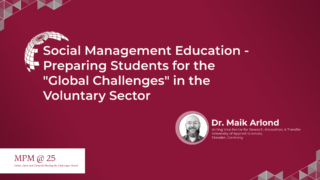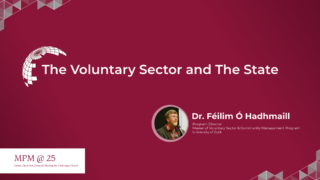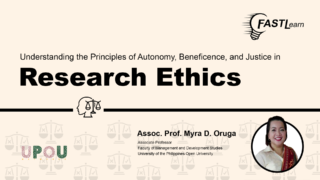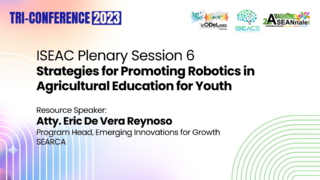The advances in information and communication technologies (ICTs) have revolutionized the education landscape worldwide. However, the same developments can pose further barriers to education when they are inappropriately utilized especially in open and distance e-learning (ODeL). A quality ODeL should be accessible to all learners and should cater to all their needs. This is imperative as ODeL-based education is considered as a tool to achieve education for all and for sustainable development. This paper discusses the concept of universal access to education and how such concept can be utilized as a framework for creating quality ODeL. It also presents a case where the accessibility concept has been integrated in the development of learning materials for ODeL courses.
With the threats posed by climate change and other hazards worldwide, access to quality education is important in creating sustainable communities. Noguchi, Guevara, and Yorzu (2015) emphasized that education played a significant role in empowering people to achieve sustainable development. O’Flaherty and Liddy (2018) indicated that education provides all learners the knowledge and skills needed to promote sustainable development. They also emphasized that education must be able to build learners’ knowledge and awareness on global issues, develop their critical thinking and analytical skills, and push them to create actions for positive social and political change. On the other hand, the United Nations Educational Scientific and Cultural Organization (UNESCO, 2002a) highlighted the important role of education in empowering learners “to assume responsibility for creating and enjoying a sustainable future.” With these goals, education must be made accessible to all, hence, UNESCO’s call for education for all and for no one to be left behind.
Meanwhile, the advances in information and communication technologies (ICTs) have recently revolutionized the education landscape. The revolution includes the creation of a more ubiquitous teaching-learning process implemented through online platforms. Online learning, e-learning, or open and distance e-learning (ODeL) does not only transform the world’s way of thinking about teaching and learning (Garrison, 2011, as cited in Otto & Becker, 2018) but also makes the learning process more accessible, even for individuals who have been marginalized from the learning opportunities offered by conventional or classroom-based education. Since teaching and learning can take place anywhere at any time, ODeL can take in diverse groups of learners, including those working and physically challenged individuals. Moreover, the proliferation of ubiquitous technologies has opened a thousand possibilities of creating a more individualized online learning environment, which might be beneficial for these students (Lei, 2010).
ICTs can also maximize the interactivity in an ODeL environment. Several research studies (Espasa & Meneses, 2010; Kuo et al., 2013; Mahle, 2011) show that interactivity plays an important role in student satisfaction. For instance, Kuo et al. (2013) reported that interactivity between the learner and instructor predicts student satisfaction, retention, and learner’s overall learning experience. When highly satisfied and motivated, ODeL learners can develop certain skills (e.g. skills to collaborate, critical thinking, lifelong learning, and skills in finding alternatives to solutions of problems) that are key to promoting sustainable development. This highlights the role of ODeL in creating sustainable communities. As Bordbar et al. (2012) has indicated, “more people at all levels must be empowered to develop the values, attitudes, and skills necessary to change behavior in regard to natural resource management” (p. 332). The opportunities offered by ODeL can simply address this need albeit not linearly.
However, the same modality could pose further barriers to education, especially for people with learning disabilities when it is inappropriately developed and implemented. It is against this background that quality has become an important issue in ODeL. A good quality ODeL should be accessible to all learners and able to cater to all their learning needs. It means that “good design for disabled people is a good design for all” (Cooper, 2006, p. 104). In addition, all interactions in the learning environment should support the learning objectives (outcomes) and address the accessibility agenda for both disabled and non-disabled learners. The paper aims to discuss the concept of accessibility in online learning and the ways it can be integrated into the teaching-learning process in an ODeL environment. It will rationalize why accessibility must be considered as a quality assurance (QA) parameter in ODeL. Towards the end, the paper presents an initiative of an ODeL-providing university in the Philippines where accessibility concepts had been incorporated in the development of learning materials.
The growth in the number of ODeL-based programs worldwide is unprecedented. With the rapid evolution of ICTs in the past few decades, several institutions are opening degree, non-degree, and short training courses via the Internet. Saeed (2019) reported a steady growth in the “number of colleges and universities that offer online educational opportunities at both the graduate and undergraduate levels” (Institutional online offerings follow enrollment trend section). This has “radically changed the landscape of modern education” where students are “learning in a new and more fluid environment” (Ferrer, 2019, Current Trends in Online Education section). The fluidity of the learning environment has attracted more and more students to enroll in ODeL. According to Saeed (2019), for instance, the number of students who are taking online courses has increased by 39% since 2012. She reported that this change points to a shifting student preference from the conventional face-to-face education to more increasingly flexible learning opportunities offered by technology-facilitated courses. Palvia et al. (2018) reported a similar observation and explained that such growth of online education is due to the “confluence of new technologies, global adoption of the Internet, and intensifying demand for a workforce trained periodically for the ever-evolving digital economy” (p.233).
While there is continuing growth in online learning enrollment, there is also a significant increase in the diversity of online learners. Brokop (2008) indicated that, among those learners who access adult education throughe-learning, a proportion are those who have learning challenges, seniors, working, and culturally different. Olney et al. (2004) also reported that the number of students with learning disabilities in online learning programs has tripled over the last twenty-five years. Brokop (2008) further indicated that people who have “grown up” with the notion of lifelong learning will continue to access educational opportunities as they age using the Internet. They would add up to the diversity of learners in ODeL.
These trends have highlighted the importance of considering accessibility in the ODeL environment. ODeL design should enhance accessibility to address online learners’ diversity and thus, minimize the marginalization of learners. In fact, Brokop (2008) identified the increasingly diverse population in an online education as a reason for adopting a universal design for learning in ODeL to increase the accessibility of learning. Enhanced accessibility is critical, especially for students with learning disabilities because most of these students do not disclose that they have a disability (Roberts, Crittenden, & Crittenden, 2011) due to social stigma, loss of esteem by professors, and fear that future employers will have access to their record (Harrison, 2003). They do not usually request accommodations to help them access course materials that were presented in an inaccessible format. Some may not know that they have a learning disability (O’Hanlon, 2005). As Kent (2015) has indicated, these students can just become invisible online. O’Hanlon (2005) suggested that instructors must know that the student who has chosen to disclose his or her learning disabilities may not be the only one in the classroom. They must understand that there may be others who are silently struggling with the course material without institutional support services (O’Hanlon, 2005). Therefore, ODeL institutions should design their online learning environment in a manner that can accommodate the learning needs of all learners. According to Cooper (2006), this approach not only levels the playing field for each learner but also makes learning more inclusive and the teaching process more motivating and supportive. Kent (2015) also recommended to put more care and thought in the development of online learning materials to make them accessible to all types of students.
But what does accessibility really mean and what should be made accessible to students? How can it then be related to the quality of ODeL experience? Cooper (2006) argued that accessibility is a multi-contextual term that educators should understand. Otherwise, they would exclude or disadvantage significant numbers of people. In the context of ODeL, Cooper (2006) defines accessibility to refer to “design qualities [emphasis added] that endeavor to make online learning available to all by ensuring that the way it is implemented does not create unnecessary barriers however the student may interact with their computer” (p. 103). It means that irrespective of any disability, each learner can interact effectively in the online teaching-learning environment. Hence, accessibility could be considered as an issue of quality rather than an ethical consideration in ODeL. How accessible the teaching-learning process in an ODeL environment is a matter of how good the quality of the instructional design of the teaching-learning process is. As Cooper (2006) has emphasized, a good quality instructional design will not only cater to the learning needs of the disabled but accommodate the learning needs of all [emphasis added] learners.
Conventionally, learning disability has been defined as the neurological disorder that creates difficulty in learning among students. Common learning disabilities are dyslexia, dyscalculia, dysgraphia, hearing and visual impairments, and the like. However, the idea of learning disability has been expanded to include more than these neurological disorders when looked at within the e-learning context. Within this context, learning disability can be defined as a “mismatch between the needs of the learner and the education offered” (IMS Global Learning Consortium, 2004, Overview of Accessibility and Meta-data section), which may arise from the context or environment the student is in (Cooper, 2006). Thus, disability can be looked at as an “artefact of the relationship between the learner and the online learning environment” or ODeL delivery system rather than a “personal trait” (Cooper, 2006, p.104). Within this frame, accessibility can then be re-defined as the ability of the learning environment to accommodate the needs of all learners instead of merely addressing the learning needs of students with a disability in the traditional sense. In other words, the ODeL environment should be flexible enough to adjust to the needs of all learners. One way to do this is to make available adequate alternatives that have equivalent contents and activities. The learning environment must be flexible in terms of presentation, control methods, access modality, and learner support (Cooper, 2006).
Considering the re-defined concept of accessibility, an important question to ask now would be “What should be made accessible to students?” Traditionally, the answer to this question involves re-adjustments on the technical components of the online teaching-learning environment. This is understandable because the objective for such adjustments is to address the needs of disabled students. However, Cooper (2006) argued that the adjustment should not only focus on meeting the learning needs of the disabled students but should consider the learning needs of a diverse group of online learners. Thus, he proposed that what should be made accessible to online learners is the learning process itself instead of the technicalities of the process. It means that ODeL designers should clearly establish the learning objectives at the outset and ensure that the process of achieving these objectives is inclusive. It is the learning objectives that must be referred to in determining the best way to make it accessible rather than the technology foreseen to be used to implement these objectives. Moreover, this should be considered at different degrees of granularity, i.e. from the overall learning objectives for the course to the learning objectives for the individual activities being mediated online” (p. 109).
With the shift from the technical consideration to the process of learning, accessibility could now be viewed as a QA issue. Thus, a good quality ODeL provides a teaching and learning process that allows online learners to achieve the stated goals of their online program or course. Although “the concept of quality in online learning is as complex as the reality of online learning itself”, a quality online learning should be able to provide strategies and means that can effectively support learners in achieving their learning goals (Butcher & Wilson-Strydom, 2013, p. 3; Oliver, 2005). This would involve high levels of deliberate and planned support for learners.
Making the accessibility issue an important consideration in the quality of ODeL means that it should be addressed even at the conceptualization and specification stage of a component of an online learning (Cooper, 2006). Further, it should not just be discovered once the learning object has been developed. There are several instances where accessibility experts have been repeatedly invited to evaluate the accessibility of an online component once it is developed. As Cooper (2006) has indicated, this is a frustrating experience to those working in accessibility because they believed that it could have been readily achieved if it had been considered at the outset. Once considered after the object has been developed, it becomes limited because of time, technical, and/or cost constraints. It is thus important that all educators should have an appreciation of the issue and an overview of how learners, especially the disabled students, may select to make effective use of the technology. As Cooper (2006) had emphasized, this general level of knowledge is important to avoid the “assumption of limitation” where educators assume that disabled students cannot effectively perform their learning tasks. “Sometimes they may think this because they have little knowledge of coping strategies adopted by blind people or technological or human support available to them” (p. 110).
Legal imperatives around the world imply that learning should be accessible to all. In the Philippines, the government has formulated a law that mandates access to quality education, even by those individuals with physical disabilities. Section 12 of Republic Act 7277, otherwise known as the “Magna Carta for Disabled Persons” states that:
“the State shall take into consideration the special requirements of disabled persons in the formulation of education policies and programs. The State is also mandated to promote the provision of auxiliary services by academic institutions that will facilitate the learning process of disabled persons” (National Council on Disability Affairs, n.d.).
To consider these provisions and allow for a more accessible learning process, the global community developed guidelines that will ensure accessibility, especially in an online environment. Among the most prominent standards conceptualized are the Web Content Accessibility Guidelines (WCAG), Universal Design for Learning (UDL), and UNESCO’s Guidelines on the Inclusion of Learners with Disabilities in Open and Distance Learning.
Web Content Accessibility Guidelines (WCAG)
The WCAG has been developed as a set of guidelines through the World Wide Web Consortium. The development has been collaborated with individuals and organizations from various parts of the globe to provide a single shared standard for web content accessibility. Such standard is expected to provide web content that meets the needs of individuals, organizations, and governments internationally (W3C Web Accessibility Initiative, 2017).
The guidelines were developed to guide primarily web content developers, web authoring tool developers, web accessibility evaluation tool developers, and others. While, related resources could be used to meet the needs of other people, including policymakers, managers, researchers, and others (W3C Web Accessibility Initiative, 2017).
Last year, the Department of Information and Communication Technology released the Memorandum Circular No. 2017–004 prescribing the W3C WCAG 2.0 as the Philippine standard for making web content more accessible to a wider range of people, including persons with disabilities.
Universal Design for Learning
Another approach that ensures wider accessibility of online learning is the Universal Design for Learning or UDL. According to the Center for Applied Special Technology or CAST (2018), UDL is a framework that can be used to “improve and optimize teaching and learning for all people based on scientific insights into how humans learn” (para. 1). It can be used to design flexible and inclusive curricula (goals, methods, materials, and assessments) that are responsive to the individual needs of the learners. The framework offers a set of concrete guidelines applicable to various disciplines or domains to ensure accessibility and participation of all learners in meaningful and challenging learning opportunities (CAST, 2018).
UDL ensures the flexibility and accessibility of the ways information is presented and on the ways students demonstrate their knowledge and skills and engage in the process of learning (Grand Valley State University, 2019). This can be exemplified on how course content is presented, peer interaction is conducted, and the like. The framework also aims to provide appropriate accommodations and supports that could reduce the barriers to learning while maintaining high achievement of the expectations of all learners (Grand Valley State University, 2019). As applied in an ODeL context, the UDL framework could create a learning environment where students with disabilities can access their courses without adaptation (Dell, Dell, & Blackwell, 2015). It also ensures that course works are made available in a variety of formats for all learners. According to CAST (2018), this could be achieved by:
1. providing multiple means of representation in terms of perception, language, expressions, symbols, and comprehension to support learning through recognition networks;
2. providing multiple means of action and expression including physical action, expression and communication, and executive function to support learning through strategic networks; and,
3. providing multiple means of engagement including recruiting interest, sustaining effort and persistence, and self-regulation to support learning through affective networks.
UNESCO’s Guidelines on the Inclusion of Learners with Disabilities in Open and Distance Learning
The guidelines on the inclusion of learners with disabilities in ODL were grounded on the World Declaration on Education for All (EFA), which was adopted in Thailand in 1990. The declaration sets out an overall vision of universalizing access to education and promoting equity (UNESCO, 2009). As such, barriers in accessing educational opportunities and resources needed to overcome them were identified proactively. Inclusion in this framework has been considered as a process of responding to the diversity of needs of all learners “through increasing participation in learning, cultures and communities, and reducing and eliminating exclusion within and from education” (UNESCO, 2009, pp. 8–9). Such process involves the transformation of content, approaches, structures, and strategies so that no learner regardless of age and cultural background would be left behind in the teaching-learning process.
Applied in an ODL, the guidelines aim to “provide an overview for governments, institutions, instructors and instructional designers, along with QA and qualifications recognition bodies, when developing ODL platforms, processes, courses, examination and others with a view of incorporating the needs of all users” (UNESCO, 2016, p. 7). The guidelines can be potentially used by ODL institutions in developing new standard procedures. In the context of educational institutions, these sets of guidelines suggest addressing the following areas: enrolment, needs assessment, strategy and internal disability policy, content, integration of open solutions, removal of barriers, training, efficacy, support services and compliance (UNESCO, 2016).
In reference to the quality of online learning, the guidelines require that the teaching and learning processes should be able to support the learning tools and content “required by all human beings to be able to survive, develop their full capacities, live and work in dignity, participate fully in the development, improve the quality of their lives, make informed decisions, and continue learning” (UNESCO, 2009, p. 10).
Established in 1995, the University of the Philippines Open University (UPOU) is one of the constituent universities of the University of the Philippines (UP), the country’s premier university. The nation’s most comprehensive distance education institution, UPOU aims to provide access to quality higher education through the Distance Education (DE) mode of teaching and learning. DE is “a mode of learning in which students and teachers are physically separated from each other, students undertake guided independent study of specially-designed learning materials in various media, and two-way communication exists between the teacher and students” (Alfonso, 2014, p. 3).
Initially, the university taught through stand-alone modules in print. Throughout the years following the rapid growth of the Internet and ICT, UPOU has adopted online teaching and learning and is now continually pushing forward in providing quality higher education through ODeL, a worldview that incorporates the values of open learning, distance education and e-learning and their intermingling to promote social transformation. Open learning, consequently, is “a vision of an educational system accessible to everyone with minimal restrictions. It emphasizes the flexibility of the system to eradicate problems caused by barriers like age, geographical location, time constraints, and economic situation” (Alfonso, 2014, p. 3).
Envisioned as a leader in teaching and learning in the digital age, UPOU is committed to its mission of providing wider access to quality higher education. In order to respond to the needs of its learners, UPOU continues to innovate and improve the quality of teaching and learning through time. One of the initiatives launched by the University is the Universal and Inclusive Accessibility Program under the @ccess flagship program set for 2016–2019. The program encompasses all aspects of academic and administrative functions and services of UPOU. It is guided by the UNESCO’s Guidelines on the Inclusion of Learners with Disabilities in Open and Distance Learning.
Responding to the University’s thrust and recognizing the importance of making online learning accessible to all learners, the Faculty of Education (FEd) implemented an Academic Program Improvement (API)-funded project, which is focused on the development of course packages with enhanced accessibility and mobility. The project aims to create course packages that are accessible and responsive to the learning needs of the learners. The project identified about 18 courses to be re-developed from the Faculty’s various degree programs.
The process of course package development in the University involves the creation of a “quality circle.” Prior to the implementation of the project, the “quality circle” consists of the content expert, external reader, instructional designer, language editor, and multimedia specialist. Bandalaria (2007) identified and described the tasks of each member of the quality circle as follows: (1) Content Expert, a subject matter expert who is responsible for writing the content of the course package, which consists of the lesson modules, course guides, assessment, and rubrics; (2) Subject Matter, also a subject matter expert who peer reviews the soundness of the course and its contents; (3) Instructional Designer who ensures the appropriateness of the chunking of lessons and the logical arrangement of the program/course goals, contents, and assessments into the learning process; (4) Multimedia Specialist who recommends the appropriate media for the delivery of content and the implementation of the teaching-learning process; and, (5) Language Editor who fixes any grammatical, punctuation, and spelling errors to enhance the material’s readability and conciseness and who ensures that the course package is consistent with the University’s style guide. Under the API-funded project, two additional members, an accessibility expert and a gender specialist, were added into the “quality circle” to integrate the principles and guidelines of accessibility, consistent with the developments in the course package development process that the university has gradually implemented through the Office of Academic Support and Instructional Services (OASIS). An accessibility expert is expected to ensure the conformity of the course packages to international guidelines for accessibility (i.e., WCAG and UNESCO’s guidelines on the inclusion of learners with disabilities in open and distance learning) while a gender specialist reviews or comments on the gender sensitivity (e.g., gender sensitivity of language, images, and/or learning activities used) of the materials.
The integration of the principles of accessibility into the course package development process involves the orientation and re-orientation of members of the “quality circle” on the various elements and guidelines of accessibility. Hence, the project organized a three-day seminar-workshop involving an expert of accessibility who is a senior educational developer from the College of Law, Australia National University (ANU) to orient potential members of the “quality circle” on the guidelines of producing course packages with enhanced accessibility and mobility. The expert discussed the process of integrating universal accessibility into the development of course packages. There were no specific accessibility needs being targeted in the integration. However, the integration was guided by the stipulations of the WCAG and the expert’s experience of such integration in their institution.
The process of creating the enhanced accessibility course packages started with the identification of the “quality circle” members. Once identified, the content expert or course writers then initiated the writing process. Close communication with them was implemented while a strong support system was developed. Research assistants were hired to closely monitor the progress of the development process, provide some clerical support such as preliminary curating open educational resources (OERs) on the internet, and document the entire process of development. The University pushed for the use of OERs in its course material development (Gervacio, Cruz, & delos Reyes, 2018). OERs are educational materials that are becoming more popular among online course designers (UNESCO, 2014) because of their public domain characteristic. According to UNESCO (2002b), they can
be freely copied, used, adapted, and re-shared since they are introduced with an open license.
Once the first draft of the course package was developed, the content expert submitted it to the project team, which in turn, submitted it to the course reader for review. All comments and suggested revisions of the package were sent back to the content expert, which in turn, revised the materials and incorporated into the revised version the suggestions of the reader. They would then submit the revised version to the project team, who in turn, submitted the document to the instructional designer, and later to the accessibility expert and gender specialist, who will ensure that all components of the course package integrated the elements of accessibility and are gender-sensitive, respectively.
The project team created a set of project monitoring sheets to easily track the progress of the course package development. Although the project has involved mostly the Faculty’s core and affiliate faculty members, it was confronted with several challenges. An assessment study conducted by the project team determined the level of integration of accessibility principles by course writers and identified the following challenges:
1. Limited Open Educational Resources: There is difficulty in finding and using OERs appropriate for the course being developed. Since the development process involved the use of OERs, course writers had trouble finding resources with enhanced accessibility for the content that they are developing. Consequently, course writers were constrained to use resources that are less accessible or inaccessible according to the WCAG guidelines. This has caused a delay in the submission of the initial draft for review and evaluation for accessibility and gender sensitivity.
2. Quick Turn-over of Accessible Resources: If they can find resources with enhanced accessibility, they are also affected by the quick turn over of these materials on the Internet. In a short span of time, the materials that the course writers have included in the package are no longer available; thus, they must find an alternative for those materials.
3. Lack of Time: Since most of the course writers are also involved in content delivery and have also teaching tasks in their home universities, they have difficulty finding time to integrate accessibility features in the course that they developed. With the enormous considerations stipulated in the WCAG guidelines (e.g., putting supplemental content when the material requires advanced reading ability, adding mechanisms for identifying specific pronunciation of words, etc.) and the limited time available for the development, course writers limited their integration into some easy-to-do considerations (e.g., repeating header rows in a table, color contrast when adding images in the material, etc.); if not, they would just skip accessibility considerations from the writing process.
4. Lack of Accessibility Experts: There is a lack of accessibility experts who can evaluate the developed course packages. It has slowed down the process of development. The accessibility expert appointed for the project was overwhelmed with the volume of packages that needed to be evaluated.
Although course writers indicated that they used WCAG in selecting resources, and developing and formatting their course packages, few of them can confidently claim that they developed their course packages with accessibility features. Most of the time, the course writers looked into the following easy-to-do considerations only as the accessibility features of the course packages they developed: (1) videos should have subtitles; (2) materials should have a good color contrast; (3) HTML version of the materials/study guide must be provided; and (4) learning materials are multimodal and downloadable.
The concern of accessibility in the teaching-learning process has grown significantly with the rising global interest in online learning. With the evolving construction of online learning coupled with advances in ICTs, the concept of accessibility has shifted from being focused on the inclusion of learners with disabilities into the teaching and learning process to meeting the diverse learning needs of all learners. International guidelines such as the WCAG, UDL, and UNESCO’s guidelines for the inclusion of learners with disabilities in open and distance learning have been formulated to provide the standards for the development of online learning materials and teaching-learning environments. Hence, accessibility has become an important quality consideration for online learning. Although the concept of quality in an online learning context is as complex as the reality of online learning itself, a quality online learning is expected to effectively support learners to achieve their learning goals. This would involve high levels of deliberate and planned support for learners, which may commence at the development of the course packages to be utilized in the teaching-learning process.
However, the integration of accessibility features in the course package development may not be without any challenges as experienced by the Faculty of Education, UPOU. Although the guidelines for integrating accessibility into the process of course materials development are readily available on the Internet, the process of integration itself may be met with difficulties that need to be addressed if accessibility will be utilized to gauge the quality of the online learning experience.
Therefore, any online learning-providing institution such as UPOU should consider developing their own OERs if it must enhance the process of integrating accessibility into its course material development process. OERs could be in video or podcast formats, which may contain accessibility features. In addition, members of the “quality circle” may be given ample time for developing the course packages. For instance, they can be given a reduced load for other tasks such as teaching and administration. Moreover, accessibility capacity building may be part of the course package development process. A series of training in accessibility can be conducted to produce individuals who can contribute to the accessibility component of the course packages to be developed. In doing so, it would not only improve the quality of the online learning or ODeL experience of the learners but also empower them to achieve their learning goals. The training could include enhancing their awareness of the existing technologies that can facilitate and check the integration of accessibility into the materials. Technologies such as WAVE, which provides a visual representation of the issues of accessibility within the page, VISOLVE, which transforms colors of the computer display into the discriminable colors, and Reading Effectiveness, which helps to find out if a draft manuscript is at the right Grade Reading Level for the intended audience can be utilized in the evaluation of the accessibility of the materials and course sites. Other tools listed in the Web Accessibility Evaluation Tools List (https://www.w3.org/WAI/ER/tools/) can also be used for certain purposes of checking the accessibility of the materials.
developing country setting: The Philippine experience. International
Review of Research in Open and Distance Learning, 8(1), 1–15.
http://www.irrodl.org/index.php/irrodl/article/view/334/792
Bordbar, M., Allahyari, M.S., Sadegh, M., & Solouki, M. (2012).
E-learning as a new technology for sustainable
development. ARPN Journal of Engineering and Applied
Sciences, 7(3), 332–337. https://pdfs.semanticscholar.
org/9dea/7d41a2d7b2ac0642cc0422831053b73438bc.pdf
Brokop, F. (2008). Accessibility to e-learning for persons with disabilities:
Strategies, guidelines, and standards. eCampusAlberta and NorQuest College. https://www.norquest.ca/NorquestCollege/media/pdf/centres/learning/Accessibility-to-E-Learning-for-Persons-With-Disabilities-Strategies,-Guidelines-and-Standards.pdf
Butcher, N., & Wilson-Strydom, M. (2013). A guide to quality in online
learning. Dallas, Texas: Academic Partnerships. https://www.chea.org/userfiles/uploads/A%20Guide%20to%20Quality%20in%20
Online%20Learning.pdf
Center for Applied Special Technology. (2018). Universal design for learning
guidelines version 2.2. http://udlguidelines.cast.org
Cooper, M. (2006). Making online learning accessible to disabled
students: An institutional case study. Research in Learning
Technology, 14, 103–115. https://www.tandfonline.com/doi/
full/10.1080/09687760500479779
Dell, C.A., Dell, T.F., & Blackwell, T.L. (2015). Applying universal design for
learning in online courses: Pedagogical and practical considerations.
The Journal of Educators, 13(2), 166–192. https://files.eric.ed.gov/
fulltext/EJ1068401.pdf
Espasa, A., & Meneses, J. (2010). Analyzing feedback processes in an online
teaching and learning environment: An exploratory study. Higher
Education, 59(3), 277–292. https://doi.org/10.1007/s10734-009-
9247-4
Ferrer, D. (2019). Current trends in online learning. The Quad. https://
thebestschools.org/magazine/current-trends-online-education/
Garrison, D.R. (2011). E-Learning in the 21st century: A framework for
research and practice. Taylor & Francis.
Gervacio, J.L., Cruz, L.N., & delos Reyes, J.M.S. (2018). Knowledge sharing
and co-creation: The UPOU’s Master of Public Management Program’s
innovation on quality assurance for ODeL. International Journal of Open and Distance e-Learning, 4(1), 1–13. http://ijodel.com/wp-
content/uploads/2018/10/001_Gervacio_etal.pdf
Grand Valley State University. (2019). eLearning and emerging technologies. https://www.gvsu.edu/elearn/accessibility-and-universal-design-for-
learning-udl-74.htm
Harrison, S. (2003). Creating a successful learning environment for postsecondary students with disabilities: Policy and practice. Journal of College Reading and Learning, 33(2), 131–45.
IMS Global Learning Consortium. (2004). Access for all meta-data overview
version 1.0 final specification. http://www.imsglobal.org/accessibility/
accmdv1p0/imsaccmd_oviewv1p0.html
Kuo, Y.C., Walker, A.E., Belland, B.R., & Schroder, K.E. (2013). A predictive study
of student satisfaction in online education programs. International Review of Research in Open and Distributed Learning, 14(1), 16–39. http://www.irrodl.org/index.php/irrodl/article/view/1338
Lei, J. (2010). Quantity versus quality: A new approach to examine the
relationship between technology use and student outcomes. British
Journal of Educational Technology, 41(3), 455–472.
Mahle, M. (2011). Effects of interactivity on student achievement and
motivation in distance education. Quarterly Review of Distance
Education, 12(3), 207–215. https://www.questia.com/library/journal/1P3-2581146811/effects-of-interactivity-on-student-achievement-and Noguchi,
F., Guevara, J.R., & Yorozu, R. (2015). Communities in action lifelong
learning for sustainable development. UNESCO Institute for Lifelong
Learning. https://files.eric.ed.gov/fulltext/ED564004.pdf
O’Flaherty, J., & Liddy, M. (2018). The impact of development education and
education for sustainable development interventions: A synthesis of
the research. Environmental Education Research, 24(7), 1031–1049.
http://doi.org/10.1080/13504622.2017.1392484
O’Hanlon, N. (2005, April 7–10). Adapting online instruction for a learning-
disabled audience [Conference session]. ACRL Twelfth National Conference, Minneapolis, Minnesota. http://www.ala.org/acrl/sites/
ala.org.acrl/files/content/conferences/pdf/ohanlon05.pdf
Oliver, R. (2005). Quality assurance and e-learning: Blue skies and pragmatism.
Research in Learning Technology, 13(3), 173–187. http://dx.doi.
org/10.1080/09687760500376389
Olney, M.F., Kennedy, J., Brockelman, K., & Newsom, M.A. (2004). Do you
have a disability? A population-based test of acceptance, denial,
and adjustment among adults with disabilities in the U.S. Journal of
Rehabilitation, 70(1), 4–9.
Otto, D. & Becker, S. (2018). E-Learning and sustainable development. In
W.L. Filho (Ed.), Encyclopedia of Sustainability in Higher Education.
Springer.
Palvia, S., Aeron, P., Gupta, P., Mahapatra, D., Parida, R., Rosner, R., & Sindhi,
S. (2018). Online education: Worldwide status, challenges, trends, and
implications. Journal of Global Information Technology Management,
21(4), 233–241. http://doi.org/ 10.1080/1097198X.2018.1542262
Saeed, J. (2019). Three (3) online education trends from 2018. https://eab.com/insights/expert-insight/academic-affairs/3-online-education-
trends-from-2018/
United Nations Educational, Scientific and Cultural Organization. (2002a).
Education for sustainability – From Rio to Johannesburg: Lessons
learnt from a decade of commitment. UNESCO. https://unesdoc.
unesco.org/ark:/48223/pf0000127100
United Nations Educational, Scientific and Cultural Organization. (2002b). Forum on the impact of open courseware for higher education in developing countries: Final report. www.wcet.info/resources/publications/unescofinalreport.pdf
United Nations Educational, Scientific and Cultural Organization. (2003).
Overcoming exclusion through inclusive approaches in education.
A challenge and a vision. UNESCO.https://unesdoc.unesco.org/
ark:/48223/pf0000134785
United Nations Educational, Scientific and Cultural Organization. (2009). Policy
guidelines on inclusion in education. United Nations Educational,
Scientific and Cultural Organization. https://bit.ly/2QBzm1C
United Nations Educational, Scientific and Cultural Organization. (2014). Communication and information. http://www.unesco.org/new/en/communication-and-information/access-to-knowledge/open-educational-resources/why-should-i-care-about-oers/
United Nations Educational, Scientific and Cultural Organization. (2016).
Learning for all: Guidelines on the inclusion of learners with disabilities
in open and distance learning. UNESCO. https://unesdoc.unesco.
org/ark:/48223/pf0000244355
W3C Web Accessibility Initiative. (2017). Web Content Accessibility Guidelines
(WCAG) Overview. https://www.w3.org/WAI/standards-guidelines/
wcag/
Bagarinao, R. T., Vereña, R. R., & Mina, C. V. (2020). Universal Accessibility: A Quality Consideration in Open and Distance e-Learning. In Quality Initiatives in an Open and Distance e-Learning Institution: Towards Excellence and Equity (pp. 53-70). Los Baños, Laguna: UP Open University.
